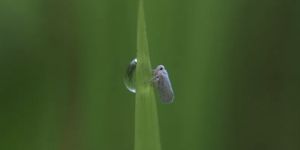Cells Can 'Walk' On a Nanofiber Tightrope
When cells were given a tiny 'tightrope' they 'walked' it, researchers have found. Reporting in the Proceedings of the National Academy of Sciences, investigators have described a new kind of cellular movement.
When cells that migrate in an organism come into contact with one another, it's thought that they will usually reverse course and move away from one another in random directions. But when provided with nanofiber tightropes, which were about 500 nanometers wide, coated with proteins, and suspended in a three-dimensional matrix, cells would move along the tightrope and past one another.
The researchers took time-lapse photography of these cells over 12 and 24 hour periods. The cells were observed either passing one another to avoid collisions, or forming a train and moving together down the nanofiber.
Cells that typically move in an erratic way began to migrate in a systematic, predictable way when they used the nanofiber, the researchers noted. This observation may help explain why some drugs have a different effect on cells that grow in culture than they do in organisms.
"A cocktail of mechanical engineering, cell biology, physics, and computational modeling reveals cell behaviors not known before," said co-corresponding study author Amrinder Nain, an associate professor in Virginia Tech's department of mechanical engineering. "Our study combines experiments with theoretical models to advance the knowledge of cell migration in vivo."
Cells in the matrix that contained the nanofiber also collided with each other differently than they do when they're moving on a flat surface. These cells did not avoid contact, and instead would share the tightrope, though they would move past each other.
Since people and animals are made of more than just one fiber, the researchers added a second, parallel nanofiber to the first. In this situation, cells would stick together and link up spontaneously to move in the same direction.
"What surprised us was that we got a huge, dramatic change from a small change in the cell's environment, moving from one fiber to two," said co-corresponding author Brian Camley, an assistant professor in the departments of Physics & Astronomy and Biophysics at Johns Hopkins University. "Instead of changing our view about the underlying biology, this shows how physical changes in the cell's environment can alter cell interactions."
This work shows how important it is to consider a cell's environment when studying how they interact with one another, Camley said.
"Scientists often want to figure out how drugs can alter cell interactions," said Camley. "It's important to study these in as natural an environment as possible, because environment plays a huge role."
Researchers have been trying on multiple fronts to make cell culture models that are more faithful to biological conditions. That led scientists to develop organoids several years ago: simple, small, 3D miniature versions of human organs. These models will certainly keep getting more complex as time goes on.
Sources: Phys.org via Johns Hopkins University, Proceedings of the National Academy of Sciences









